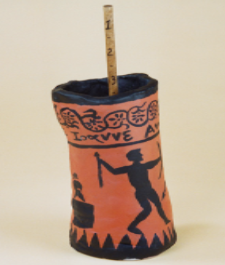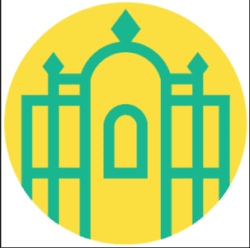Decoding Device, Greece, 5th Century BCE
A riddance am I asking of the gods
From these my toils, this watch a whole year long,
Which plying, as I lie, propped on my arm
Upon the Atridae’s house-top, like a dog,
I have learnt the congress of the nightly stars,
And those who bring to mortals cold and heat,
Bright potentates, set proudly in the sky.
And now I am watching for the signal torch,
The flame of fire, bearing from Troy a tale,
The tidings of its fall: for so is best,
Since my queen’s manlike spirit waits in hope.
— Aeschylus, Agamemnon
It is believed that the advance news of the capture of Troy by the Greek commander Agamemnon was communicated through beacons. Though there really is no evidence that proves that beacons were in fact used for communication during the time of the Trojan War, Aeschylus’s play suggests that this form of communication was used during his time (525-455 BCE). These beacons, which were simple prearranged signals, served as precursors to the telegraph. It was the Greek military scientist named Aeneas Tacticus who developed this ingenious method of communicating messages using the simplest torch signals in the 4th century BCE.
The way in which this system works is that two armies who wish to communicate with each other would have to create two sets of identical equipment. Each army would have the same earthenware or clay jar with a hole of exactly the same size drilled on the bottom side of the jar. In addition, each army would have a wooden (or cork) float with a rod attached to it. The diameter of the float should be slightly smaller than that of the clay jar. The rod would have clearly marked section with numbers partitioning each section. Each number would represent a military message, like the “corn has arrived” or “don’t let the big wooden horse in”. The messages on the rod would have to be identical and both armies would have to agree on the most useful messages.
The earthenware jar would be filled with water and the hole at the bottom would be plugged using a cork piece allowing the wooden piece to float inside of the jar. When army A wanted to communicate to army B, a signalman would wave a torch (like in Agamemnon) until it is spotted by signalman B who would then, in return, respond by waving his torch. When contact in established each signalman would unplug his jar simultaneously letting the water drain out. The cork float would then slowly sink to the bottom of the jar while a myriad of numbers inscribed on the rod sink. Signalman A would then raise his torch when the appropriate message that he wished to communicate reaches the eye level of both signalman. Ideally, because the equipment should be identical, the floats would sink at the same rate and thus communicate the same message at the same moment. Though this method is a bit inefficient, it would be virtually impossible for anyone outside of these two armies to crack the code.
Method of Construction
Constructed by: Joanne Chang ’99, Anna Soellner ’98, and Kristien Knapp ’99
Oh the trials and tribulations of this project… The construction of the rod and the float were quite simple. The rod was cut to size using a band saw. The float made of pinewood, the lightest kind of wood available to us, was cut into a circular form using drill like saw. We then drilled a hole of a similar diameter as the rod into the float and pushed the rod into the hole. Using an indelible marker we then marked numbers onto the rod and shellacked the rod and float twice so it would not ruin the wooden piece when placed in water.
The heartache came with making the clay pot. Since no one in the group knew anything about throwing clay on a wheel it took many, many hours for all of us to wedge the clay (get rid of all the air bubbles) and construct the jar. However, because we did not make the clay jar under anyone’s supervision no one was willing to let us fire the piece in their kiln (they were afraid that our piece would explode, which it probably would have). Therefore, we were forced to come up with a quick and easy way to waterproof the clay jar. We finally decided to use Thompson’s Water Seal *and* shellac the inside of the pot twice. Though the project was completed at this point we decided to use our artistic license and paint ancient patterns on the jar using acrylic paints. The hole on the bottom side of the jar was created by poking a cork through the clay while it was still wet.
Resources
The inspiration to recreate the military decoding jar came from Peter James and Nick Thorpe’s text Ancient Inventions: Wonders of the Past! (1994, Ballantine Books, New York).




